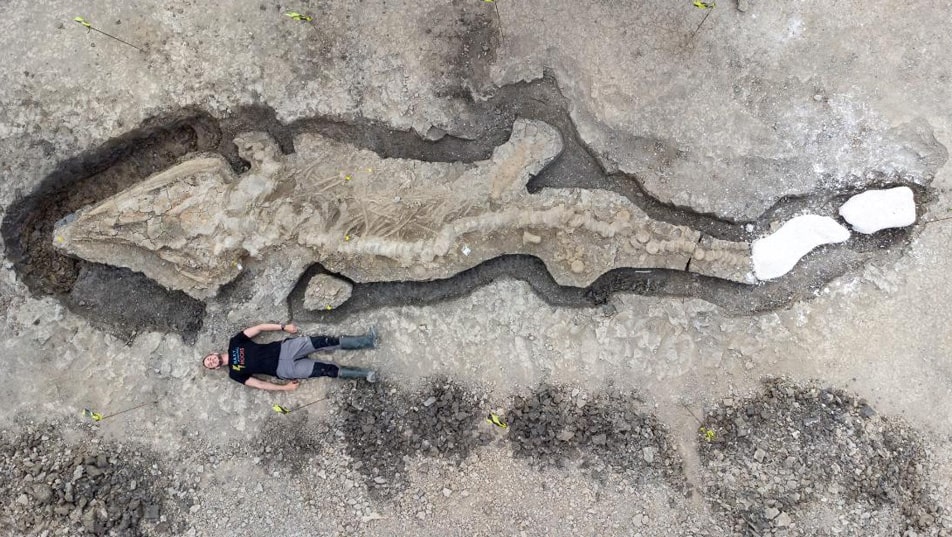Nothing quite grips the imagination of the public like the discovery of a dinosaur fossil or that of some other large vertebrate. Such was the case this week when the chance find of bones, peeking out from sediments near Rutland Water turned out to be those of a 180 million year (Ma) old marine reptile, an ichthyosaur, informally named the Rutland Sea-Dragon but more scientifically referred to as Temnodontosaurus trigonodon. These organisms are well-known but the scale and completeness of this particular find, marked it out as exceptional. Perhaps the most amazing image was that of the completely excavated skeleton with excavation leader Dean Lomax (University of Manchester) lying alongside it (see below). The University of Birmingham is part of the science team behind the project.
 Photograph credited to Anglian Water
Photograph credited to Anglian Water
No doubt the scale of this fossil commanded much attention but at microscopic scale there’s a wealth of information regarding the age of the specimen and providing a glimpse into the Early Jurassic seas that this majestic creature once swam through.
The fossil sat in soft clays and silts of what’s known as the Whitby Mudstone Group, exposed in an arc from the Yorkshire Coast, through the East Midlands, eventually reaching the famous Dorset Jurassic Coast. Take a small sample (half a handful) of this sediment, wash away the clays and silts and you are left with a plethora (often hundreds) of sand grain-sized objects that are fossils in their own right, this is the world of the microfossil. The study of microfossils (micropalaeontology) has long been associated with the University of Birmingham and today the School of Geography, Earth and Environmental Sciences (GEES) hosts the largest group of academic micropalaeontologists in the UK.
In the past, I have worked with the same excavation team to help understand the origin (geological age and even location) of similar large fossil vertebrates that currently reside in museums but were poorly recorded at the time of collection, especially during the Victorian period. They were originally exhibited as curios rather than valued for scientific research. By analysing microfossils from small fragments of the sediment (or matrix) that surrounds these specimens, we have been able to give a deeper context to some of these objects (including one in our own Lapworth Museum of Geology, Lomax et al., 2017). This work has been in conjunction with Dr Phil Copestake (Merlin Energy Resources Ltd), a long-time GEES collaborator and world expert in one particular group of microfossils. In the summer of 2021 I was invited along to the Rutland Water excavation to undertake a microfossil study of the sediments surrounding the ‘sea-dragon’.
So, why bother with these small fossils when you have the truly stunning 10 metre behemoth to examine and display? The answer is in the question, what can a single specimen tell you about a Jurassic world when we know that our modern ecosystems are so complex? So far, our study of the microfossils has revealed two important details.
 Examples of Early Jurassic microfossils, scale bar is 1 mm
Examples of Early Jurassic microfossils, scale bar is 1 mm
First, although we know that ichthyosaurs lived from about 250 to 90 Ma ago, and this species is known to range from about 175 to 183 Ma, we are able to match-up our microfossil species with those from well-dated sequences elsewhere (a technique called biostratigraphy) allowing us to date the specimen to 181.5 to 182 Ma. Our second discovery was that this creature inhabited a well-lit, warm-water environment with a rich ecosystem in terms of both phytoplankton in the surface water and invertebrates on the sea-floor (crustaceans, protistans, sea-urchins, sea-lilies, brittle stars all of which are represented by microscopic fossil remains representing almost 50 separate species.
From a few grams of sediment, containing 100s of microfossils, we can bring ancient worlds to life. Sometimes there really is, more than meets the eye.